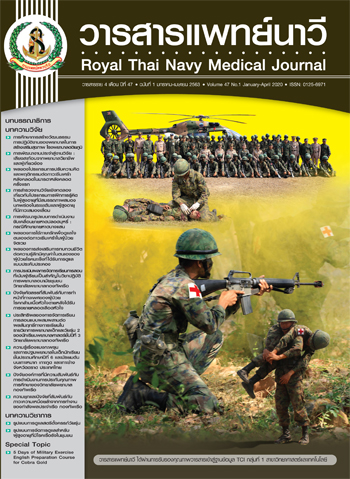Jellyfish Sting and First Aid Knowledge among 6th- 9th Grade Students in Koh Mak, Koh Kood, and Koh Chang, Trat Province, Thailand
Main Article Content
Abstract
The aim of this research was to investigate the knowledge of jellyfish stings and first aid management among 458 6th- 9th grade students living in Koh Mak, Koh Kood, and Koh Chang in Trat province. Other objectives were to investigate the relationship between basic demographic features, acquaintance with beaches, and previous experiences with jellyfish stings and first aid training. Data was collected using a questionnaire developed by the investigator based on literature review, and distributed to all 6th- 9th grade students living on these three islands. Variables with normal distribution were presented as mean (standard deviation : SD) and those without a normal distribution were presented as median (interquartile range : IQR). Qualitative variables were presented with counts and percentages. Relationship between total knowledge score and independent variables were assessed by Fisher’s exact test and multiple logistic regression.
Results showed that two hundred and eighty-four students (62.01%) had adequate knowledge. Students from Koh Kood had the highest percentage of adequate knowledge. Comparing by class, students from 9th grade had the highest percentage of knowledge. Female students (67.14%) had higher adequate knowledge when compared to males. The relationship between students’ baseline characteristics and total knowledge score was assessed by multiple logistic regression. Ninth-grade students had 3.22 times higher adequate knowledge compared to 6th grade students (95% CI 1.64, 6.33). Female students had 1.57 times higher adequate knowledge compared to male students (95% CI 1.00, 2.46).
Suggestions: Students from Koh Mak had the least adequate knowledge on toxic jellyfish stings and first aid when compared to students from Koh Kood and Koh Chang. We should offer more education on this topic to students by including it into science curricula, health education subjects, or extra-curricular activities. Information on appropriate first aid management of jellyfish stings, via simple infographic material, can be provided to students, residents, and resort operators on these islands. Everyone should be aware of the severity associated with toxic jellyfish stings to create an effective preventive measure.
Article Details

This work is licensed under a Creative Commons Attribution-NonCommercial-NoDerivatives 4.0 International License.
References
2. Lakkis NA, Maalouf GJ, Mahmassani DM. Jellyfish stings: a practical approach. Wilderness Environ Med 2015;26(3):422-9.
3. Thaikruea L, Siriariyaporn P. The magnitude of severe box jellyfish cases on Koh Samui and Koh Pha-ngan in the Gulf of Thailand. BMC Res Notes 2016;9(1):108.
4. Thaikruea L, Siriariyaporn P. Severe dermatonecrotic toxin and wound complications associated with box jellyfish stings 2008-2013. J Wound Ostomy Continence Nurs 2015;42(6):599-604.
5. Fenner P. Awareness, prevention and treatment of world-wide marine stings and bites. [Internet]. [cited 2018 November 1]. Available from: https://www.ilsf.org/sites/ilsf.org/files/filefield/treatmentofmarinestings.pdf.
6. Central Database System and Data Standard for Marine and Coastal Resources. Thailand: Department of Marine and Coastal Resources; c2013 [updated 2020 Jan 3]. [Internet]. [cited 2020 January 4]. Available from: https://km.dmcr.go.th/th/c_1/s_365/d_15246
7. Associated Press. U.N. honors girl for saving 100 in tsunami. TDN.com [Internet]. [cited 2019 Dec 27]. Available from: https://tdn.com/news/u-n-honors-girl-for-saving-in-tsunami/article_a313838d-4fa7-526d-9598-bab253b74cbb.html.
8. Thaikruea L, Siriarayaporn P. Injuries and deaths caused by toxic jellyfish: surveillance, prevention, and treatment. Chiang Mai: Faculty of Medicine of Chiang Mai University; 2018.
9. Kan T, Gui L, Shi W, Huang Y, Li S, Qiu C. A survey of jellyfish sting knowledge among naval personnel in northeast China. Int J Environ Res Public Health 2016 Jul 19;13(7). doi: 10.3390/ijerph13070725.
10. de Pender AM, Winkel KD, Ligthelm RJ. A probable case of Irukandji syndrome in Thailand. J Travel Med 2006;13(4):240-3.
11. Suriyan S, Haruethaikan K, Piyachat RE. A survey of jellyfish sting knowledge among Thai divers in Thailand. Int Marit Health 2019;70(1):11-6.
12. Cegolon L, Heymann WC, Lange JH, Mastrangelo G. Jellyfish stings and their management: a review. Mar Drugs 2013;11(2):523-50.
13. Tibballs J, Li R, Tibballs HA, Gershwin LA, Winkel KD. Australian carybdeid jellyfish causing "Irukandji syndrome". Toxicon 2012;59(6):617-25.
14. Fenner PJ, Lippmann J, Gershwin LA. Fatal and nonfatal severe jellyfish stings in Thai waters. J Travel Med 2010;17(2):133-8.


